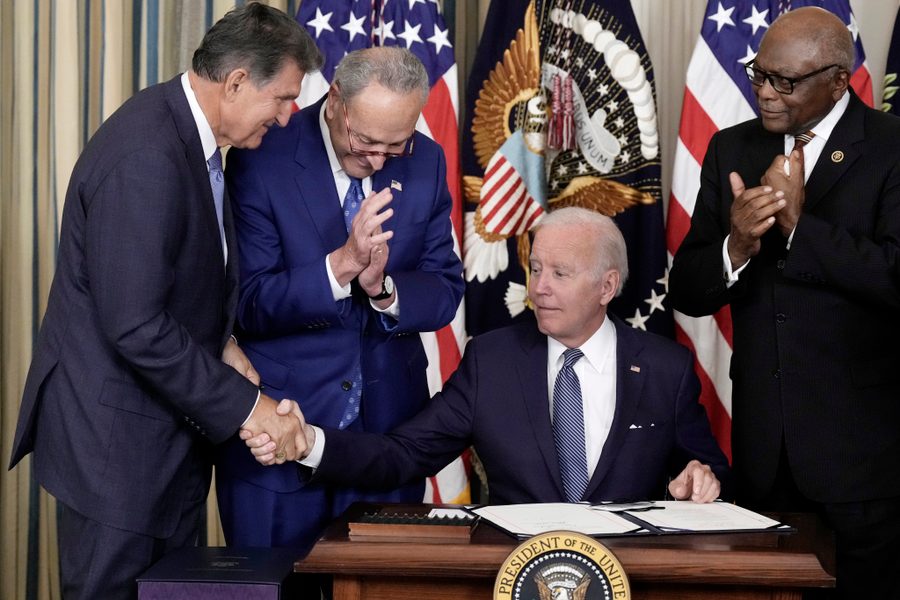Now That the IRA Is Law, the Climate Movement’s Fight Has Just Begun
After President Biden’s signing of a “historic” climate bill, environmental organizers have plenty of work ahead to undo the IRA’s worst provisions while keeping fossil fuels in the ground.
Mitch Jones

Climate activists and grassroots organizers are wrestling with the contradictions embedded in the Inflation Reduction Act (IRA), signed into law by President Biden on August 16. The IRA is undoubtedly the U.S. federal government’s largest-ever investment in clean energy and climate action, but it also commits to major investments in sustaining dirty fossil fuels, relies on profit-driven markets to deliver climate benefits, and banks on industry-backed solutions like “carbon capture” to magically produce technological feats that so far have failed.
So, is this what winning for the climate movement feels like?
Broadly speaking, public policy is often reduced to carrots (subsidies and sweeteners) and sticks (regulations and penalties). The IRA is all carrots: extending and expanding tax credits to spur growth in wind and solar production while giving consumers a little cushion to make buying an electric car or upgrading appliances more affordable. If you believe that public policy can create meaningful change via modest incentives in the private marketplace, the IRA has something to offer.
But to get the deal, Democratic leaders had to make some trades, and, as a result, clean energy growth on public lands will depend on an oil and gas leasing bonanza. Not so long ago, President Biden campaigned on a pledge to end fracking on public lands. So what is billed as a landmark climate achievement all but guarantees that fracking will continue to expand.
According to IRA proponents, these kinds of trade-offs are worth it. They insist that the law’s presumed climate pollution reductions will be far more impactful than the new drilling and fracking, or the massive new gas export facilities that will continue being incentivized. But that doesn’t jibe with reality. Recent analysis from Food & Water Watch, based on evidence from the last decade, shows that promoting cleaner energy while still advancing new fossil fuel projects blunts our progress in ending climate pollution. As the report states, “The viability of renewable electricity provides an off-ramp from climate chaos, but if fossil fuel development continues unchecked, we will be locked in to decades of continued carbon emissions and climate crisis.”
Nevertheless, we are told by proponents that the law will reduce climate emissions by about 40 percent over the next ten years. This claim is misleading, as the law actually requires no emissions cuts at all. What these optimistic models suggest is that, due to the law, greenhouse gas emissions could drop 42 percent compared to the high point of 2005. Yet we’re about halfway to that goal already, and the same models predict 27 percent further reductions will happen without any new laws at all.
So how is this progress accounted for? Lots of new wind and solar energy, of course, as well as a substantial increase in electric car purchases. One of the most popular models assumes that every car sold in the United States will be an electric model by 2030. While that is possible, it would seem unlikely without some type of mandate.
The law and these pollution projections also hinge on a massive buildout of what’s known as “carbon capture” — the much-hyped but entirely unproven and unrealized technology that would capture emissions and bury them underground. Boosters of carbon capture assume (or at least want us to assume) that all the scheme needs to succeed is billions of dollars more in government subsidies, which the Inflation Reduction Act delivers. This is an odd argument, as the federal government has been massively subsidizing fledgling carbon capture projects for more than a decade already. The result so far has been zero success in cost-effectively capturing and disposing of climate emissions in any significant quantity.
What sounds good in theory — capturing pollution — is very different in practice. To date, the carbon capture industry exists almost exclusively to service the extraction and burning of more fossil fuels. In a process known as enhanced oil recovery, some captured gasses are being pumped into existing oil and gas wells in order to drive more product out of the ground — akin to the process behind fracking. As a result, carbon capture has contributed to a vicious cycle of fossil fuel dependence.
Which brings us to the matter of the so-called “side deal” negotiated by Democratic Sens. Joe Manchin (W.V.) and Chuck Schumer (N.Y.). Under the guise of “permitting reform,” this deal intends to fast-track fossil fuel expansion, curtail public input and weaken regulatory oversight. The details are yet to be determined, but a draft outline of the bill (which could be attached to a must-pass annual spending measure in September) calls for the designation of at least five new massive fossil fuel infrastructure projects as being of “strategic national importance.”
So even before the ink has dried on the Inflation Reduction Act, environmental and climate justice advocates are regrouping for the next battle. Given the explicit provisions of the IRA that bolster the fossil fuel industry, and the threat of more to come under the Manchin-Schumer “side deal,” the climate movement has found itself with scarcely little to celebrate, and plenty more to fight.
Mitch Jones is the managing director of policy at Food & Water Watch, a national advocacy organization.



